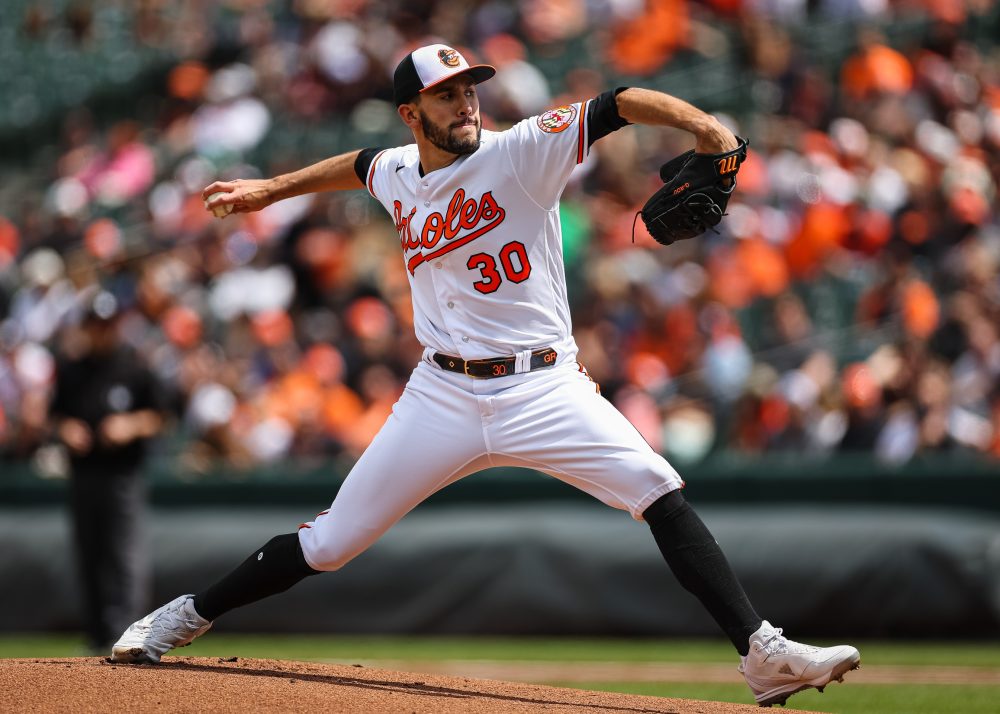
When I was a young boy, I didn’t understand the point of sermons. It usually wasn’t my problem; I would gather on the red carpeted stairs with the other children and listen as the kindly old man with the colorful stoll gave us the condensed version of what would be repackaged, interminably, for the adults after we got hustled off to Sunday school. The messages were always fair enough—be kind to people even when they’re not kind to you, own up to your mistakes and apologize for them—but I couldn’t imagine extending the metaphors out. Even at six I could start to see the patterns repeat. The message was fine, but why would adults need to be told the same thing week after week?
And then I went into sportswriting. Ron Shelton once compared baseball to church, its stadiums the cathedrals, and that makes us, in a sense, the (self-appointed) pastors. Half of baseball writing, and that estimate is a kindness, is telling people to settle down, rearranging the words like magnetic poetry. It’s giving the sermons while at the same time calling attention to the patterns, ending in a cadence every bit as rhythmic as the beat of the game itself. Stop reading too much into April. Stop looking at contracts from the owner’s perspective. Stop wishcasting momentum into every game.
We repeat these mantras because, as is so often the case in life, the stuff that’s the most boring is also the most important. Baseball and morality have aspects to them that are incredibly self-evident, to the point of being ridiculous to talk about, but also you have to: Like the golden rule, you just have to keep pounding it in. Take, for example, one of the simplest sabermetric concepts out there: the count.
I have some issues with how we talk about the count. Mostly, they stem from baseball’s rare asymmetry: four balls and three strikes make for an ugly circle. There’s “ahead of the count” and “behind in the count,” which mean different things depending on who, batter or pitcher, we’re referring to. Then there’s the “hitter’s count,” which usually means 2-0 or 3-1, also described as fastball counts back when pitchers felt compelled to throw fastballs. The “pitcher’s count” is basically just two strike counts except when full. And worst of all are the even counts, which are only even in one direction: an even number of balls and strikes thrown, but not an even number remaining. Is 1-1 truly even? In terms of results, no count beyond 0-0 really is.
One aspect of the count we all generally know, but rarely bother to talk about, is that the count is more important on an individual basis than the batter. You’d probably rather face Jacob Stallings, say, with the bases loaded and the game on the line than Shohei Ohtani. But spot the catcher a 2-1 count, and he slashed .245/.437/.377 in 71 2022 plate appearances from that point in the at-bat on. Compare that to Ohtani with just a first-pitch strike, and he was good for .247/.289/.426.
This would lead you to agree with the platitude that the most important pitch is 0-0, since getting ahead of the batter is so crucial. And that’s true as a general skill, because you have to throw a 0-0 pitch in every plate appearance. But again, on the individual level, the most important pitch is the most obvious one: 3-2, where a ball is a free base and a strike is an out, with no other possibilities between them. Getting ahead is great, avoiding the fastball count is fine, but the third strike is everything. Strike three eliminates dark timelines. Here’s a breakdown of league wOBA through each count for 2022:
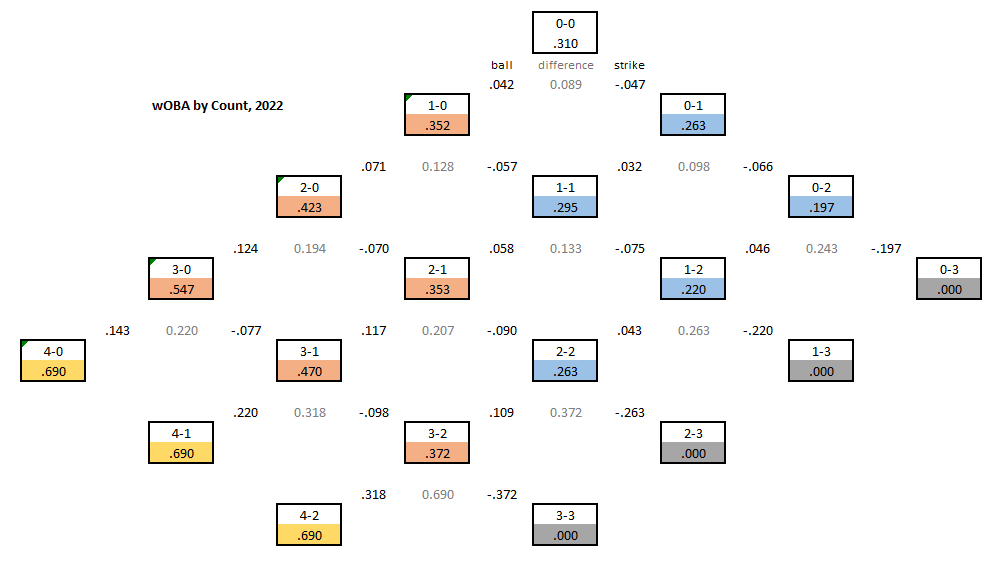
As you can see, “even” counts are actually pitcher’s counts, and the anonymous 1-0 and 2-1 counts lean toward the hitters. This effect, it should be noted, comes with a major asterisk: All count data is, in a sense, self-fulfilling. Good hitters are more likely to work favorable counts, and therefore favorable counts are going to produce better results. (Aaron Judge saw more than 50% more 3-1 counts than Dansby Swanson, in a nearly identical number of plate appearances.) Ben Clemens wrote a piece for FanGraphs several years ago that strained out the effects, finding that the effect is lessened, but still unshakeable.
On the pitching side, the magic lies in getting to two strikes. Strike three is the end, but strike two introduces the possibility of strike three, reducing every hitter to a shell of himself. Scan a leaderboard of pitchers with the most and least two-strike counts, and it’ll look like a leaderboard of who’s good or bad at pitching. The same guys who can miss bats twice are likely to do it again. But in 2023, there’s been one troubling little exception:
| Starters, 2023, Favorable Counts (250+ Pitches) (through 4/26) | ||
| Pitcher | Ahead in Count | wOBA |
| Garrett Whitlock | 60% | .231 |
| Spencer Strider | 56.5% | .141 |
| JP Sears | 55.7% | .305 |
| Joe Ryan | 55.2% | .183 |
| Drew Rasmussen | 54.8% | .146 |
| Jacob deGrom | 54.6% | .125 |
| Grayson Rodriguez | 54% | .374 |
| George Kirby | 53.7% | .243 |
This article is not about JP Sears. Ordinarily you’d be thrilled to lodge your name in any leaderboard just below deGrom and Rasmussen, but the O’s top prospect Rodriguez has been completely unable to put hitters away, yielding an incredible .353 batting average and .510 slugging percentage in counts where the league averages are .218 and .347. In situations designed to make Ohtani look like Stallings, Rodriguez is making everyone look like Ohtani.
Ordinarily, you’d see a young pitcher getting punished like this on balls in play and your inclination might be that he’s throwing too many strikes, tossing away the advantage of the expanded zone he’s created for himself. So far in 2023, however, that hasn’t been true: He’s only thrown 40 of 113 two-strike pitches in the strike zone, a 35% rate that might be a touch higher than necessary but is far from Miles Mikolas territory. The problem is that those 73 pitches outside the zone are only tricking batters into swinging 42% of the time, barely higher than a pitcher like Kevin Gausman draws with his splitter across all counts. Worse yet, nearly half of those swings were fouls, holding the count steady. Too often, hitters weren’t fooled on Grayson’s out pitches, forcing him to work deeper into counts, becoming less efficient, and prone to making mistakes.
On a 2-2 count to Tyler Nevin, Rodriguez tries the standard: a slider curling out of the zone. But it curls a little too much, too early, and Nevin realizes before his toe taps that he’s got no chance of even reaching it:
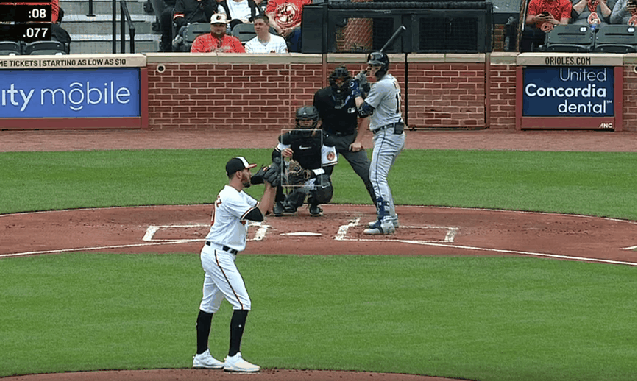
This time it’s a 2-2 changeup to Riley Greene, a pitch that plunges down rather than westward. Greene is caught by surprise—by the way he scoots back, he’s reading slider—which works in his favor, since he’s unable to chase. If Grayson had been able to locate that pitch on the outside, where Adley Rutschman had set up, Greene probably swings over the top of it.
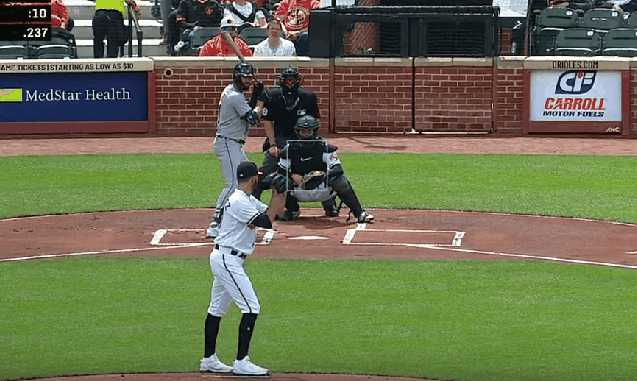
And lastly, to righty Kevin Smith, Grayson misses his mark again, this time by starting the slider too far in. Like the first slider above, he leaves it up as well, putting it easily within the shortstop’s reach. Rodriguez knows it before the ball even reaches the plate.
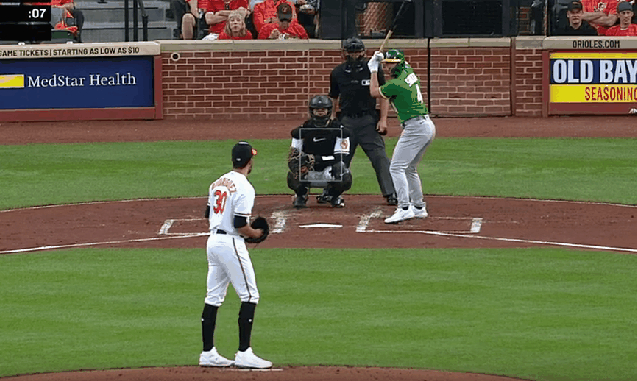
What does it all mean? Almost nothing. That’s because every baseball platitude eventually crashes into the biggest one of all: It’s only April. You want this to mean something, but it doesn’t. We’ve been spoiled in recent years by rookies bursting onto the scene, and it’s only recently that rookies as a whole have come back to earth, as we’ve seen with the likes of Spencer Torkelson and MacKenzie Gore. It’s undeniable that Rodriguez has an adjustment to make: He’s setting himself up for success as much as any starter in baseball, and then throwing away the advantage he’s made for himself by wasting too many pitches. But it’s far better to be making those kinds of mistakes on 1-2 than it is on 3-1; half-done work is better than none.
Eventually, Rodriguez is either going to make that adjustment, start the breaking pitches in the zone before moving out of it, and lure those bats to follow. Even if he struggles, batters are going to close their eyes and wave at some anyway, because hitters make mistakes just like pitchers do. And eventually, in some blessed stretch, both of those things are going to happen, and we’re going to get the Grayson Rodriguez we promised ourselves. And it’ll be amazing, because you’ll ignore the sportswriters who keep telling you it’ll regress, just like the rough patch from April you’d long since forgotten. It’s fine. If you sleep through the sermon you can just catch the next one.
Thank you for reading
This is a free article. If you enjoyed it, consider subscribing to Baseball Prospectus. Subscriptions support ongoing public baseball research and analysis in an increasingly proprietary environment.
Subscribe now